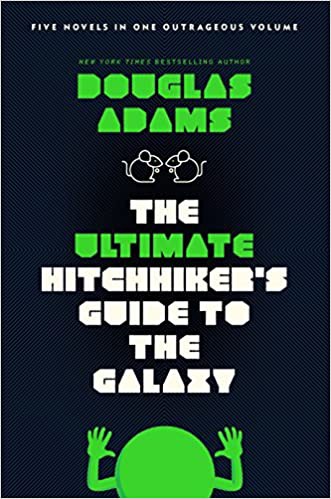领域分类的问题
One of the common issues I find early-stage engineers facing is how to position themselves on a team in such a way as to be given work they’d enjoy doing. All too often folks feel stuck, feeling like code monkeys, just executing their manager’s vision.
我发现,早期工程师面临的常见问题之一是如何以一种能够享受他们喜欢的工作的方式将自己置于团队中。 人们常常感到卡住,就像代码猴子一样,只是执行经理的愿景。
So what do you do if the tasks your manager hands down to you aren’t interesting? What do you do when every day at work feels like a drag? You watch other engineers be given interesting, fun challenges and think “But what about me?”
因此,如果经理交给您的任务不有趣怎么办? 每天上班时感觉像阻力一样,您会怎么做? 您会看到其他工程师面临有趣,有趣的挑战,并想:“那我呢?”
简短的文学作品 (A brief literary aside)

If you haven’t already read Douglas Adams’ The Hitchhiker’s Guide to the Galaxy, go read it. Now. I’ll wait.
如果您尚未阅读道格拉斯·亚当斯(Douglas Adams)的《银河系旅行者指南》,请阅读。 现在。 我会等。
The book is chock full of fun, interesting asides that have nothing to do with the main story but that nevertheless can be supremely enlightening.
这本书充满乐趣,有趣的方面与主要故事无关,但仍然可以启发人。
One of those is the Somebody Else’s Problem Field. As a refresher, Arthur (the main character), and Ford (his friendly alien companion) are stuck in London, trying desperately to get off planet, when Ford starts acting weird — hopping up and down on one foot, looking at something out of the corner of his eye. When Arthur asks Ford what he’s doing, Ford says “I think there’s a spaceship right there, cloaked with Somebody Else’s Problem Field. If you don’t stare at it directly, you might notice it.”
其中之一是“其他人的问题”字段。 提神时,主角亚瑟(Arthur)和福特(他的友好外星同伴)被困在伦敦,当福特开始表现怪异时,他们拼命地试图脱下行星-一只脚上下跳动,看着外面的东西他的眼角。 当亚瑟(Arthur)问福特在做什么时,福特说:“我认为那边有一艘宇宙飞船,被别人的问题场掩盖了。 如果您不直接凝视它,您可能会注意到它。”
其他人的问题领域… (The Somebody Else’s Problem Field…)
… is a field that covers an issue with a cloak of invisibility. It makes it so people ignore an issue even though it’s staring them right in the face.
…是一个涉及隐身斗篷问题的领域。 这样一来,即使是直视他们的人,人们也不会理会这个问题。
Know any issues like that in your organization?
知道您组织中有类似的问题吗?
You know one of the key differentiators between a Junior and a Senior engineer? Seniors drive Somebody Else’s Problems. (Let’s call them SEPs for short.) Notice I didn’t say “Seniors fix SEPs.” That’s not scalable, especially since SEPs are often higher scope than a lone IC can fix. I really mean drive. So what does driving look like in this context? Let’s work through an example.
您知道高级工程师和高级工程师之间的主要区别之一吗? 老年人驾驶别人的问题。 (让我们简称为SEP。)请注意,我没有说“高级人员修复 SEP”。 这是不可扩展的,特别是因为SEP的范围通常比单个IC可以解决的范围大。 我的意思是开车 。 那么在这种情况下驾驶是什么样的呢? 让我们来看一个例子。
示例1:蜿蜒的入职 (Example 1: The Meandering Onboarding)

It’s your first day at a new job. Your computer, your email account, and your password are all waiting at your new desk. (when does that ever happen?)
这是您从事新工作的第一天。 您的计算机,您的电子邮件帐户和密码都在新办公桌旁等待。 (什么时候会发生?)
But then the problems start. Your account hasn’t been added to all the assets you need. The team Wiki is a mess. When you try to build the codebase, you hit one error after another.
但是问题开始了。 您的帐户尚未添加到所需的所有资产中。 团队Wiki一片混乱。 当您尝试构建代码库时,您遇到另一个错误。
<days of pain and misery later, involving asking multiple coworkers for info, banging your head against the monitor, praying…>
<几天后的痛苦和痛苦,涉及向多个同事询问信息,将头撞在监视器上,祈祷…>
You have your first build two weeks later. Since you’re now feeling under pressure for not delivering sooner, and feeling somewhat stupid, you roll up your sleeves and start on your first assignment.
两个星期后,您便拥有了第一个版本。 由于您现在正面临无法尽快交付的压力,并且感到有些愚蠢,因此您会卷起袖子开始进行第一次作业。
结果 (Outcome)
Meh. Just a standard onboarding experience for most of us. The next hire’s going to have exactly the same experience. At least you got to Slack several key developers on the team.
嗯 对于我们大多数人来说,这只是标准的入职体验。 下一位员工将拥有完全相同的经验。 至少您需要Slack团队中的几个关键开发人员。
替代结果 (Alternative outcome)
Let’s say on day 2 you went to your manager and asked for permission to delay your onboarding by 1–2 weeks, so you could work on fixing up the documentation/script/config issues as you encounter them. Would your manager say no? Doubtful. You’re not the first team member to have gone through this pain, you’re just the first to offer to help.
假设在第2天,您去了您的经理,并请求允许将入职时间推迟1-2周,以便您在遇到问题时可以解决文档/脚本/配置问题。 您的经理会拒绝吗? 疑。 您不是第一个经历过这种痛苦的团队成员,您只是第一个提供帮助的成员。
So, now you’ve got a couple weeks’ leeway. What do you do with it? Well, engage key developers on the team. Validate with them that the issues you’re seeing are, in fact, legitimate, and not just you being dense. Enlist them to help you diagnose the root causes. Formulate a plan of attack, run it past your manager.
所以,现在您有几个星期的余地。 你用它做什么? 好吧,请团队中的关键开发人员参与进来。 与他们一起验证您所看到的问题实际上是合法的,而不仅仅是您的问题。 征求他们帮助您诊断根本原因。 制定攻击计划,将其通过您的经理。
分析 (Analysis)
Onboarding is the most obvious and most common example of an SEP, and, admittedly, one that can often be executed rather than driven. (It’s relatively small-scope, depending on team/etc.) But there are plenty of tasks that are higher-scoped than that, where you will need allies and contributors. Great! Those give you a chance to increase your scope at your own pace, and make friends and expand your network in the meanwhile.
入职是SEP的最明显和最常见的示例,并且可以承认,通常可以执行而不是驱动。 (这是一个相对较小的范围,取决于团队/等等。)但是,还有许多范围更广的任务,而在这些任务中,您将需要盟友和贡献者。 大! 这些使您有机会按自己的步调扩大自己的范围,同时结交朋友并扩展您的网络。
Note that I’m not recommending you ignore your normal, daily tasks, in favor of chasing an SEP. That’s a sure way to earn the wrath of your manager. Instead, consider enlisting your manager in the SEP you find yourself passionate about. Ask her for help in the right approach to the problem. Ask if she’d mind if you spend 5%, 10% of your time on driving the issue forward. Assuming you’re not struggling in the day-to-day tasks, and assuming you can explain the business value of solving the SEP, it’s a poor manager who would object to you going after it.
请注意,我不建议您忽略常规的日常任务,而是追求SEP。 这是赢得经理愤怒的肯定方法。 相反,可以考虑让您的经理参加您发现自己充满热情的SEP。 向她寻求帮助,以正确的方式解决问题。 询问她是否介意您是否将5%,10%的时间用于推动问题发展。 假设您没有在日常工作中挣扎,并且假设您可以解释解决SEP的商业价值,那位可怜的经理会反对您执行SEP。
I’m also not saying “Jump on every SEP you see.” As my friend Kurt so rightly says,
我也不是说“跳到您看到的每个SEP”。 就像我的朋友库尔特(Kurt)正确说的那样,
There is some risk in addressing a perceived SEP as a brand-new team member when one’s understanding of context for the problem is still evolving. Conversely, having the understanding of where co-workers are wasting cycles repeatedly on a task that isn’t a daily one but continues to be problematic and not acting is a party foul. — Kurt Heston
当人们对问题的背景知识的理解仍在不断发展时,将一个公认的SEP作为一个全新的团队成员存在风险。 相反,了解同事在何处反复浪费时间来完成一项并非日常任务的任务,但仍然存在问题且不采取行动,这是聚会的犯规。 —库尔特·赫斯顿
It’s a fine line to walk, and the key to walking it is passion: go after the SEPs you’re passionate about. There should be more than zero, but it won’t be every one you see.
这是一条不错的路线,而走路的关键是热情:追寻您热衷的SEP。 应该大于零,但不会是您看到的每个数字。
优点 (Advantages)
There are several advantages to this SEP way of thinking, aside from the obvious: in one stack rank meeting after another, I’ve seen folks who pick up and drive SEPs rise to the top of the stack. Why? Because they’re showing the key attributes every (good) organization wants: ownership, drive, initiative, dealing with ambiguity, communication.
除了显而易见的之外,这种SEP思维方式还有很多优点:在一个又一个的栈级会议中,我已经看到那些接过并推动SEP升至栈顶的人。 为什么? 因为它们显示了每个(好的)组织想要的关键属性:所有权,动力,主动性,处理歧义,沟通。
Also, consider these:
另外,请考虑以下因素:
- You are entirely in control of the task you want to take on. Nobody will think less of you for not picking up an SEP — by its very definition, nobody expects you to. So you’re free to pick the SEP that arouses your interest. Go after the ones you’re passionate about. You’ll be more successful driving them, anyway. 您完全可以控制要执行的任务。 没有人会因为没有参加SEP而对您的想法更少-从其定义上来说,没有人期望您这么做。 因此,您可以自由选择引起您兴趣的SEP。 追寻您最热爱的人。 无论如何,您将更加成功地驾驶它们。
- The failure scenario is much less likely. There are generally no timelines associated with SEPs. If there were, they wouldn’t be SEPs. So you can take as long as you want to resolve them. (Though, of course, the faster you do it, the better.) There is no real way to fail: if your drive peters out, well, the SEP is where it was before you picked it up: grudgingly ignored by everyone else. 失败的可能性要小得多。 通常没有与SEP相关的时间表。 如果有的话,它们就不会是SEP。 因此,您可以花很长时间来解决它们。 (当然,这样做的速度越快越好。)没有真正的失败方法:如果您的硬盘逐渐消失,那么,SEP就是您选择它之前的状态:被其他所有人勉强忽略。
- By picking up the SEP, you become the team’s recognized expert in that area. Driving the issue to resolution establishes you as the one who knows the most about it, even if you weren’t the one to do all the actual work of solving it! This then makes you the obvious choice the next time some task comes up in the same general area. So not only have you increased your scope, you’ve also repositioned your role more to your liking. Awesome, right? 通过选择SEP,您将成为团队在该领域的公认专家。 将问题推向解决方案,这将使您成为最了解问题的人,即使您不是真正解决问题的人! 这样,当您下次在同一常规区域中执行某些任务时,这便成为显而易见的选择。 因此,您不仅扩大了范围,而且还根据自己的喜好对角色进行了重新定位。 太好了吧?
那么,如何找到一个不错的,多汁的SEP? (So how do I find a nice, juicy SEP?)
The problem is, just like in Arthur/Ford’s example, if you stare directly at an SEP it’s hard to see. In other words, if you sit down one day and say to yourself “All right, Biff, I’m going to find me an SEP to solve now,” chances are you’ll spend an hour staring at the monitor, coming up with nothing.
问题是,就像在Arthur / Ford的示例中一样,如果您直接凝视SEP,将很难看到。 换句话说,如果您有一天坐下来对自己说:“好的,Biff,我现在要找到我要解决的SEP。”您可能会花一个小时盯着显示器,想办法没有。
The trick to catching an SEP is being aware of what’s happening in your work life moment by moment. Did you just have to code around a turd in a feature area implementation? That’s an SEP. Write it down.
赶上SEP的诀窍是时刻了解工作中正在发生的事情。 您是否只需要在功能区实现中围绕草皮编写代码? 这是SEP。 写下来。
Did you just spend half an hour on a weird build issue on your local machine? SEP.
您是否只是在本地计算机上花了半个小时解决一个奇怪的构建问题? 9月。
Did you just spend ten minutes searching through the wiki to find an answer you needed?
您是否只花了十分钟在Wiki上搜索以找到所需的答案?
Did you just have to message your teammates for help with an environment issue that everyone knows about but nobody wants to tackle head-on?
您是否只需要向队友发送消息以寻求大家都知道但没人愿意正面解决的环境问题的帮助?
SEP, SEP, SEP.
SEP,SEP,SEP。
Write them down. Then, when you get into that 2 hours of carved-out time, look at this list. Pick one you’re most passionate about. And go at it!
记下来。 然后,当您进入那两个小时的时间时,请查看此列表。 选择一个您最感兴趣的。 去吧!
验证假设 (Validating Assumptions)
There are two assumptions behind everything I’m saying above.
我上面所说的一切背后都有两个假设。
- Your organization is healthy and work culture is not toxic. Collaboration is encouraged, initiative is rewarded. 您的组织健康,工作文化无毒。 鼓励合作,积极主动。
- Your manager is supportive, exemplifies the “got your back” attitude, and genuinely wants the best for you. 您的经理是支持者,体现了“忘我”的态度,并真诚地希望为您提供最好的服务。
If either of these assumptions don’t apply to your work situation, I’d really recommend switching jobs. (If the second doesn’t apply, switch teams. If the first, switch companies.)
如果这些假设中的任何一个都不适合您的工作状况,那么我真的建议您更换工作。 (如果第二个不适用,请更换团队。如果第一个不适用,请更换公司。)
Seriously. People carry emotional scars from their toxic work environments for years. If you can manage to find something better, why wouldn’t you?
说真的 人们多年来在其有毒的工作环境中留下了情感上的疤痕。 如果您能够找到更好的东西,为什么不呢?
您去了,有必要的免责声明 (There you go, and necessary disclaimers)
As usual, the views above are my own, and aren’t meant to represent Adobe or Microsoft. Feel free to hit me up on Twitter @partnerinflight, comment below, or shoot me an email at partnerinflight@gmail.com.
与往常一样,以上观点是我自己的观点,并不代表Adobe或Microsoft。 请随时在Twitter @partnerinflight上打我,在下面发表评论,或通过partnerinflight@gmail.com向我发送电子邮件。
And if you like these posts, share them! Perhaps they’ll be helpful to somebody else, too.
如果您喜欢这些帖子,请分享! 也许它们也会对其他人有所帮助。
本系列的其他条目: (Other entries in this series:)
Like what you read? Want to read more? Here’s the complete list of articles so far (in suggested order of reading):
喜欢你读的书吗? 想了解更多吗? 这是到目前为止的文章的完整列表(按建议的阅读顺序):
翻译自: https://medium.com/swlh/the-somebody-elses-problem-field-671cb9460eac
领域分类的问题




















 2379
2379











 被折叠的 条评论
为什么被折叠?
被折叠的 条评论
为什么被折叠?








